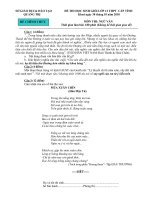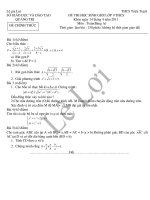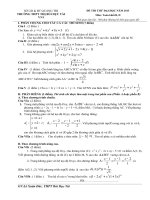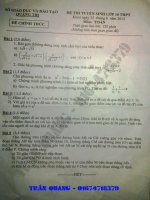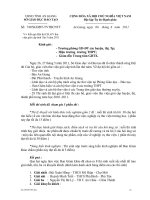unit 6870 ngoại ngữ 6 hồ thị minh sang thư viện giáo dục tỉnh quảng trị
Bạn đang xem bản rút gọn của tài liệu. Xem và tải ngay bản đầy đủ của tài liệu tại đây (136.91 KB, 6 trang )
<span class='text_page_counter'>(1)</span><div class='page_container' data-page=1>
<b>Week 24 Date- preparing: 14/2/2009</b>
<b>Period 68 Date- teaching: 16/2/2009</b>
<b>UNIT11: WHAT DO YOU EAT? </b>
<b>LESSON 4: B 1,3,4</b>
<b> A. Objectives: </b>
By the end of the lesson, students might practice offers and requests
more fluently
<b>I, Knowledge</b>
: practice offers and requests for food and drink, using “
a, an and.
<b>II, Skills</b>
: Listening and speaking
<b> B. Procedures</b>
:
<b> </b>
<b>I, Settlement </b>
Greeting and check attendance
<b>II, Warm up: Kim’s game</b>
<b>-</b>
Have students look at the picture of food / drink in B1 on
page119 and try to remember as many words as possible.
<i><b>Rice noodles beef chicken fish vegetables</b></i>
<i><b>Oranges bananas orange juice milk soda water</b></i>
<b>III, New lesson:</b>
<b>Teacher's activities</b>
<b>Students' activities</b>
<b>Lead in: </b>
Use the Warm up part to introduce
the new lesson
<b>1 Presentation </b>
<b>Act 1:Presentation pictures : B3 on page</b>
<b>119</b>
- What would you like for
<i><b>breakfast</b></i>
<i>?</i>
- I’d like
<i><b>some</b></i>
<i> milk and </i>
<i><b>a</b></i>
<i> banana. </i>
- What would you like for
<i><b>lunch</b></i>
<i>?</i>
- I’d like some meat, vegetables and
<i><b>an</b></i>
<i>orange.</i>
-
<i><b>What would you like for + N(meal)?</b></i>
-
<i><b>I’d like some / a / </b></i>
<i><b>an………</b></i>
2. Practice.
<b>Act 1: Picture drill</b>
- Show students the picture .
- Say the model sentences:
+ What would you like for
<i><b>breakfast</b></i>
<i>?</i>
<i>+ I’d like </i>
<i><b>some milk</b></i>
<i>.</i>
- Students read the dialogue in A2 on
page 116 again .
- Make the questions to isolate the
model sentence:
-How much beef do you want?
-How many eggs do you want?
- Look at the pictures.
- Listen to the teacher.
- Repeat it chorally and then
individually.
</div>
<span class='text_page_counter'>(2)</span><div class='page_container' data-page=2>
+ What would you like for
<i><b>lunch</b></i>
<i>?</i>
+ I’d like some
<i><b>rice</b></i>
<i> , fish and </i>
<i><b>a</b></i>
<i><b>banana</b></i>
- Run through the pictures.- Hold up the
first picture and say the model sentences:
<i>+What would you like for lunch?</i>
<i>+ I’d like some meat, rice and vegetables.</i>
- Do the same for the second picture.
- Correct their mistakes.
- rice - soda
- noodles - meat
- bananas - fish
<b>3.Further practice: </b>
act 1: Survey
<i><b>What would you </b></i>
<i><b>like for….? </b></i>
<i><b>Name and food or</b></i>
<i><b>drink</b></i>
<i><b>break-fast </b></i>
<i><b>lunch </b></i>
<i><b>dinner</b></i>
<i><b>………..</b></i>
<i><b>…………..</b></i>
- Get students to fill in their real names and
what time they do the following things.
- Get them to practice in pairs:
+ What would you like for …?
<i> + I ‘d like some / a / an ……….</i>
- Feedback.
- Practice in pairs.
<b>-</b>
Some pairs practice in front
<i><b>Example exchange: </b></i>
<i>+S1: What would you like for lunch?</i>
<i>+S2: I’d like some meat, rice and</i>
<i>vegetables</i>
- Fill in their real names and what time
they do the following things.
- Practice in pairs.
- Tell the teacher what they have asked
their partner, e.g.“Lan would like some
<i>milk and bread for her breakfast……… </i>
<b>IV. Consolidation</b>
:
<b>Retell the story</b>
- Revise the lesson by asking Ss how to use requests for food and
drink, using “ a, an and
<b>V. Homework</b>
:
- Ask students to learn vocabulary and offers / requests for food and
drink.
<b>-</b>
Have them prepare Unit 11 - L 5 :(B5,6):Talking about prices of
<i>food and drink with “How much…?” </i>
</div>
<span class='text_page_counter'>(3)</span><div class='page_container' data-page=3>
<b>UNIT11: WHAT DO YOU EAT?</b>
<b>LESSON 5: B 5,6</b>
<b> A. Objectives: </b>
At the end, students might use “ How much ……… “ to talk about
prices.
<b>I, Knowledge</b>
:
Talking about prices for food and drink with “ How much………”.
<b>II, Skills</b>
:
Speaking<b> B. Procedures</b>
:
<b> </b>
<b>I, Settlement </b>
Greeting and check attendance<b>II, Revision: Slap on board</b>
<b>III, New lesson:</b>
<b>Teacher's activities</b>
<b>Students' activities</b>
<b>Lead in: Use the Warm up part to introduce the </b>
new lesson
<b>1 .Presentation: </b>
<b> Act 1:Vocabulary:</b>
(a) sandwich: def
the canteen : sit
a bowl of noodles : pic
<b>-</b> Elicit the words from Ss
<b>-</b> Model, then write down and does concept
check
* Checking vocabulary: R.O.R
<b>2. Presentation text</b>
- Ask students to read a menu in A5 on page 120
then answer some questions about prices to isolate
the model sentence:
+ <i> How much is a fried rice?</i>
+ <i> How much is a cake?</i>
<i> </i>+ <i> How much is a sandwich?</i>
- Let students copy the notes in their notebooks
and memorize
<b>+ Target language: </b>
<i><b> How much is / are…?</b></i>
<i><b>It’s / they’re </b></i>
Form: <i><b>- How much + be + S ?</b></i>
<i><b> - It / they + be + price</b></i>
- Listen to the teacher.
- Repeat after the teacher.
- Notice the main stress pattern.
- Write the new words in their notebooks.
- Students read the menu.
- Answer the questions about prices to isolate
the model sentence:
+ <i>It’s 2,500 </i>
+ <i>It’s 500 </i>
+<i> It’s 1,500 </i>
<b>-</b> Copy the notes in the notebooks and
memorize
100 110 150 1000
550
</div>
<span class='text_page_counter'>(4)</span><div class='page_container' data-page=4>
Use: ………..
<b>3. Practice:</b>
<b>Act 1: Board drill</b>
<i><b>How much is / are…?</b></i>
<i><b>It’s / they’re </b></i>
- Put a menu on the board.
- Run through the phrases.
-Do the same for the second cue.
<b>4.Further practice:</b>
<b>Act 1: Nought and crosses</b>
- Put the grid on the board.
- Divide class into teams. One is noughts (O) and
the other is Crosses (X).
- Two teams choose any words in the boxes and
ask questions about prices .
- The team which has three noughts or three
crosses on a line will win the game
<b>2,500dong</b> <b>10,000dong</b> <b>8,500dong</b>
<b>25,000dong</b> <b>1,800dong</b> <b>1,100dong</b>
<b>500dong</b> <b>200dong</b> <b>15,000dong</b>
Read the shopping list.
Read the phrases.
<i>- a fried rice 2,500</i>
<i>- a bowl of noodles 3,000</i>
<i>- a sandwich 1,500</i>
<i>- a cake500</i>
<i>- an orange juice 1,800</i>
<i>- a lemon juice 1,000</i>
<i>- an ice-cream 2,000</i>
- Look at the board.
- Work in groups.
- One is noughts (O) and the other is Crosses
(X).
- Choose any words in the boxes, ask and ask
questions about prices :
<i>+How much is it / are they?</i>
<i>+It is 500.</i>
<i>+ They are 10,000</i>
<b>IV. Consolidation</b>
:
- Ask Ss to evoke the way how to talk about the price
<b>V. Homework</b>
:
- Ask students to learn vocabulary and structures (Unit 11).
- Have them do exercises in the exercise book from page 43 to 46 and
prepare GRAMMAR PRACTICE: like, a/an/some/any, adjectives question
<i>words………… </i>
<b> Date- preparing: 18/2/2009</b>
<b>Period 70 Date- teaching: 20/2/2009</b>
<b>GRAMMAR PRACTICE</b>
<b> A. Objectives: </b>
-
At the end, students will be able to produce language better.</div>
<span class='text_page_counter'>(5)</span><div class='page_container' data-page=5>
adjectives, question words, present Progressive, simple present and
quantifiers
<b>II, Skills</b>
:
Speaking and writing<b> B. Procedures</b>
:
<b> </b>
<b>I, Settlement </b>
Greeting and check attendance<b>II, Checking up: </b>
<b>-</b> Give some prices of some things, ask Ss to make questions and
answers
A banana / 500dong two pens/ 3000dong
<b>III, New lesson:</b>
<b>Teacher's activities</b>
<b>Students' activities</b>
<b>Lead in: Introduce the task of new lesson</b>
<b>1.Present simple tense: </b><i><b>Like</b></i>
<b>Act 1</b><i><b>: </b></i><b>Dialogue build.</b>
- Read the dialogue and write few key words on
the board to help students remember what the two
speaker in the dialogue say to each other .
- Get students to write in the missing words on the
board.
<b>-</b> Ask students to write the missing words on
the board
<b>2. A / an / some / any:</b>
<b>Act 1: Nought and crosses</b>
- Put the grid on the board.
- Divide class into teams. One is noughts (O) and
the other is Crosses (X).
- Two teams choose any words in the boxes and
ask questions about feelings .
- The team which has three noughts or three
crosses on a line will win the game.
<i><b>1. any 2. any 3. some 4. some 5. any</b></i>
<i><b>6. some 7. any 8. some 9. a</b></i>
<b>3. Adjectives:</b>
<b>Act 1: Pelmanism.</b>
- Stick 10 cards on the board so that the students
can only see the numbers, make sure the words are
mixed up.
- Divide the class into two teams and ask students
to choose two numbers.
-Answer the teacher’s question.
- Look at the board and listen to the teacher
carefully.
- Reproduce the dialogue from the cues.
- Build the dialogue until it is memorized.
- Write in the missing words on the board.
<i><b> a) </b>- Do you ____ noodles?</i>
<i> - Yes, I _____ noodles.</i>
<i> - _____ you _____ rice?</i>
<i> - No, ____ ____ ____ rice.</i>
<i> <b>b) </b>- ____ she____ chicken?</i>
<i> - Yes. She ____ chicken.</i>
<i> - ____ she ____ fish?</i>
<i> - No. She ____ ____ fish. </i>
- Look at the board.
- Work in groups.
- One is noughts (O) and the other is Crosses
(X).
- Choose any words in the boxes, ask and ask
questions about feelings :
<i>+Do you have any bananas?</i>
<i>+No, I don’t have any bana..</i>, <i>but I have some</i>
<i>oranges</i>
- Look at the board.
- Listen to the teacher’s explanation.
- Work in teams.
- One of student in each team chooses any
two numbers.
</div>
<span class='text_page_counter'>(6)</span><div class='page_container' data-page=6>
- Go on until the cards are turned over.
<b>4.Question words: </b>
<b>Act 1: Lucky numbers</b>
<b> 1 2 3 4 5 6 7 8 </b>
- Write the numbers on the board.
- Divide class into teams. The teams take turn to
choose the numbers.
<b>-</b> Tell students that they have to answer the
questions .
<b>5. Present simple & present progressive </b>
<b>tense:</b>
<b>Act 1: Transformation drill</b>
<b> - </b><i><b>S + Vs / es ………(every day)</b></i>
<i><b> - S + is / am / are + Ving…(now)</b></i>
<b>a)</b> <i>is eating </i><b>d)</b><i> is going</i>
<b>b)</b> <i>are drinking </i><b> e)</b><i> is getting</i>
<i><b>c.</b></i> <i>is riding </i><b>f)</b><i> is traveling</i>
- Ask students to remind Present simple and
present progressive tense.
- Ask students to have to turn into a new
sentences using present progressive tense.
- Look at the board.
- Work in teams.
- Take turn to choose the numbers.
- Listen to the teacher carefully.
- Answer the questions.
<b>1 </b><i><b>Lucky number</b></i><b>. 7 - a Who</b>
<b> 2 - b What 8 - e Where</b>
<b> 3 - d What</b>
<b> 4 </b><i><b>Lucky number</b></i><b>. </b>
<b> 5 - c How</b>
<i><b> 6. Lucky number</b></i><b>. </b>
- Remind Present simple and present
progressive tense.
- Have to turn into a new sentence using
progressive tense.
<b>IV. Consolidation</b>
:
- Revise the main structures of the lesson.
<b>V. Homework</b>
:
- Ask students to review vocabulary and Grammar points (Unit9 – Unit11)
and exercises in the exercise book from Unit 9 to Unit 11 .
</div>
<!--links-->

